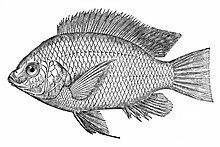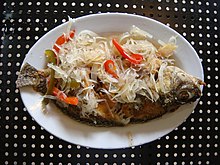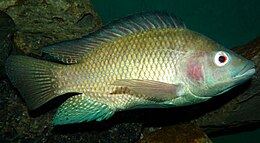The London Aquarium: St Peter's fish
The London Aquarium: St Peter's fish
The London Aquarium: St Peter's fish
History

The Tomb of Nakht, 1500 BC, contains a tilapia hieroglyph just above the head of the central figure.
Tilapia go by many names. The aquaculture of Nile tilapia goes back to Ancient Egypt, where it was represented by the hieroglyph K1,
of the Gardiner List.
Tilapia were one of the three main types of fish caught in Biblical times from the Sea of Galilee. At that time they were called musht, or commonly now even "St. Peter's fish". The name "St. Peter's fish" comes from the story in the Gospel of Matthew about the apostle Peter catching a fish that carried a coin in its mouth, though the passage does not name the fish.[3] While the name also applies to Zeus faber, a marine fish not found in the area, a few tilapia species (Sarotherodon galilaeus galilaeus and others) are found in the Sea of Galilee, where the author of the Gospel of Matthew accounts the event took place. These species have been the target of small-scale artisanal fisheries in the area for thousands of years.[4][5]
|
The common name tilapia is based on the name of the cichlid genus Tilapia, which is itself a latinisation of thiape, the Tswana word for "fish".[6] Scottish zoologist Andrew Smith named the genus in 1840.[7]
Characteristics

Other than their temperature sensitivity, tilapia exist in or can adapt to a very wide range of conditions. One extreme example is salton sea, where tilapia introduced when the water was brackish now live in saltwater so salty that it kills marine fish. [9]
Species
Tilapia as a common name has been applied to various cichlids from three distinct genera: Oreochromis,[10] Sarotherodon[11] and Tilapia.[12] The members of the other two genera used to belong to the genus Tilapia but have since been split off into their own genera. However, particular species within are still commonly called "tilapia" regardless of the change in their actual taxonomic nomenclature.The delimitation of these genera among each other and to other tilapiines requires more research; mtDNA sequences are confounded because at least among the species of any one genus, there is frequent hybridization. The species remaining in Tilapia in particular still seem to be a paraphyletic assemblage.[13]
Exotic and invasive species
See also: Tilapia as exotic species
Tilapia has been used as biological controls for certain aquatic
plant problems. It has a preference for a floating aquatic plant, duckweed (Lemna sp.) but also consume some filamentous algae.[14] In Kenya tilapia were introduced to control mosquitoes which were causing malaria, because they consume mosquito larvae, consequently reducing the numbers of adult female mosquitoes, the vector
of the disease (Petr 2000). These benefits are, however, frequently
outweighed by the negative aspects of tilapia as an invasive species.Tilapia are unable to survive in temperate climates because they require warm water. The pure strain of the blue tilapia, Oreochromis aureus, has the greatest cold tolerance and dies at 45 °F (7 °C), while all other species of tilapia will die at a range of 52 to 62 °F (11 to 17 °C). As a result, they cannot invade temperate habitats and disrupt native ecologies in temperate zones; however, they have spread widely beyond their points of introduction in many fresh and brackish tropical and subtropical habitats, often disrupting native species significantly.[15] Because of this, tilapia are on the IUCN's 100 of the World's Worst Alien Invasive Species list.[16] In the United States, tilapia are found in much of Florida, Texas, and a few other isolated areas like power plant discharge zones. Tilapia are also currently stocked in the Phoenix, Arizona canal system as an algae growth control measure. Many state fish and wildlife agencies in the United States, Australia, South Africa, and elsewhere consider them to be invasive species.[17]
Aquarium species
Larger tilapia species are generally poor community aquarium fish because they eat plants, dig up the bottom, and fight with other fish. However, the larger species are often raised in aquariums as a food source, because they grow rapidly and tolerate high stocking densities and poor water quality.Smaller West African species, such as Tilapia joka and species from the crater lakes of Cameroon, are more popular. In specialised cichlid aquaria, tilapia can be mixed successfully with nonterritorial cichlids, armored catfish, tinfoil barbs, garpike and other robust and dangerous fish. Some species, including Tilapia buttikoferi, Tilapia rendalli,Tilapia mariae, Tilapia joka and the brackish-water Sarotherodon melanotheron melanotheron, have attractive patterns and are quite decorative.[18]
| This article is one of a series on |
| Commercial fish |
|---|
| Large pelagic |
| billfish, bonito mackerel, salmon shark, tuna |
|
|
| Forage |
| anchovy, herring menhaden, sardine shad, sprat |
|
|
| Demersal |
| cod, eel, flatfish pollock, ray |
| Mixed |
| carp, tilapia |
Commercial species
The tilapiiness of North Africa are the most important commercial cichlids. Fast-growing, tolerant of stocking density, and adaptable, tilapiine species have been introduced and farmed extensively in many parts of Asia and are increasingly common aquaculture targets elsewhere.| [hide]Principal commercial tilapia species | ||||||||||
|---|---|---|---|---|---|---|---|---|---|---|
| Common name | Scientific name | Maximum length |
Common length |
Maximum weight |
Maximum age |
Trophic level |
Fish Base |
FAO | WoRMS | IUCN status |
| Nile tilapia | Oreochromis niloticus (Linnaeus, 1758) | 60 cm | cm | 4.324 kg | 9 years | 2.0 | [19] | [20][21]| style="text-align:center;"| [22] | Not assessed | |
| Blue tilapia | - Oreochromis aureus (Steindachner, 1864) |
45.7 cm | 16 cm | 2.010 kg | years | 2.1 | [23] | [24] | ||
| Nile tilapia + blue tilapia hybrid | cm | cm | kg | years | ||||||
| Mozambique tilapia | Oreochromis mossambicus (Peters, 1852) | 39 cm | 35 cm | 1.130 kg | 11 years | 2.0 | [26] | [27] | [28]| |
|
Wild species
Aquaculture
Main article: Aquaculture of tilapia
Farmed tilapia production is about 1,500,000 tonnes (1,500,000 long
tons; 1,700,000 short tons) annually with an estimated value of US$1.8
billion,[30] about equal to that of salmon and trout.Unlike carnivorous fish, tilapia can feed on algae or any plant-based food. This reduces the cost of tilapia farming, reduces fishing pressure on prey species, avoids concentrating toxins that accumulate at higher levels of the food chain and makes tilapia the preferred "aquatic chickens" of the trade.[31]
Because of their large size, rapid growth, and palatability, tilapiine cichlids are the focus of major farming efforts, specifically various species of Oreochromis, Sarotherodon, and Tilapia, collectively known colloquially as tilapia. Like other large fish, they are a good source of protein and popular among artisanal and commercial fisheries. Most such fisheries were originally found in Africa, but outdoor fish farms in tropical countries, such as Papua New Guinea, the Philippines, and Indonesia, are underway in freshwater lakes.[32] In temperate zone localities, tilapiine farming operations require energy to warm the water to tropical temperatures. One method uses waste heat from factories and power stations.[33]
China is the largest tilapia producer in the world, followed by Egypt.[34]
In modern aquaculture, wild-type Nile tilapia are not too often seen, as the dark color of their flesh is not much desired by many customers, and because it has a bit of a reputation of being a trash fish associated with poverty.[35] On the other hand, they are fast-growing and give good fillets; leucistic ("Red") breeds which have lighter meat have been developed and these are very popular.
Hybrid stock is also used in aquaculture; Nile × blue tilapia hybrids are usually rather dark, but a light-colored hybrid breed known as "Rocky Mountain White" tilapia is often grown due to its very light flesh and tolerance of low temperatures.[35]
Commercially grown tilapia are almost exclusively male. Cultivators use hormones, such as testosterone, to reverse the sex of newly spawned females. Because tilapia are prolific breeders, the presence of female tilapia results in rapidly increasing populations of small fish, rather than a stable population of harvest-size animals.[36]
Other methods of tilapia population control are polyculture, with predators farmed alongside tilapia or hybridization with other species.[37]
As food

Escabeche fresh tilapia

Redbelly tilapia, Tilapia zilli ("St. Peter's fish) served in a Tiberias restaurant
Tilapia is one of several commercially important aquaculture species (including trout, barramundi and channel catfish) susceptible to off-flavours. These ‘muddy’ or ‘musty’ flavours are normally caused by geosmin and 2-Methylisoborneol, organic products of ubiquitous cyanobacteria that are often present or bloom sporadically in water bodies and soil.[41] These flavours are no indication of freshness or safety of the fish, but can harm the reputation of a product in the eyes of the consumer. Simple quality control procedures are known to be effective in ensuring the quality of fish entering the market.
Tilapia have very low levels of mercury,[42] as they are fast-growing, lean and short-lived, with a primarily vegetarian diet, so do not accumulate mercury found in prey.[43] Tilapia are low in saturated fat, calories, carbohydrates and sodium, and are a good protein source. They also contain the micronutrients phosphorus, niacin, selenium, vitamin B12 and potassium.[44]
The lower amounts of omega-3 and the higher ratios of omega-6 fats in US-farmed tilapia raised questions about the health benefits of consuming farmed tilapia fish. Some media reports even controversially suggested that farm-raised tilapia may be worse for the heart than eating bacon or a hamburger.[45] This prompted the release of an open letter, signed by 16 science and health experts from around the world, that stated that both oily (i.e. high in omega-3 fatty acids) fish and lean fish like tilapia are an important part of the diet and concluded that "replacing tilapia or catfish with 'bacon, hamburgers or doughnuts' is absolutely not recommended."[46]
Multiple studies have evaluated the effects of adding flaxseed derivatives (a vegetable source of omega-3 fatty acids) to the feed of farmed tilapia. These studies have found both the more common omega-3 fatty acid found in the flax, ALA and the two types almost unique to animal sources (DHA and EPA), increased in the fish fed this diet.[47][48] Guided by these findings, tilapia farming techniques could be adjusted to address the nutritional criticisms directed at the fish while retaining its advantage as an omnivore capable of feeding on economically and environmentally inexpensive vegetable protein. Adequate diets for salmon and other carnivorous fish can alternatively be formulated from protein sources such as soybean, although soy-based diets may also change in the balance between omega-6 and omega-3 fatty acids.[49]
More recent studies have called into question the value of omega-3 fatty acids relative to omega-6 fatty acids; several randomized controlled trials failed to show that omega-6 fatty acids caused an increase in heart disease,[50][51][52] while a study involving 70,000 patients in Greece found administering omega-3 supplements provided no health benefits.[53]
The US produced 1.5 million tons of tilapia in 2005, with 2.5 million projected by 2010.[54]
Miscellaneous uses
Tilapia, young and mature, of Tamil Nadu
Tilapia rarely compete with other "pond" fish for food. Instead, because they consume plants and nutrients unused by other fish species and substantially reduce oxygen-depleting detritus; adding tilapia often increases the population, size and health of other fish.
Arizona stocks tilapia in the canals that serve as the drinking water sources for the cities of Phoenix, Mesa and others. The fish help purify the water by consuming vegetation and detritus, greatly reducing purification costs.
Arkansas stocks many public ponds and lakes to help with vegetation control, favoring tilapia as a robust forage species and for anglers.
In Kenya, tilapia help control mosquitoes which carry malaria parasites. They consume mosquito larvae, which reduces the numbers of adult females, the disease’s vector.[56]
Tilapia also provide an abundant food source for aquatic predators.
This article is about the fish that fall under the term tilapia in common usage. For species belonging to the genus Tilapia, see Tilapia (genus).
Nile tilapia, Oreochromis niloticus








No comments:
Post a Comment